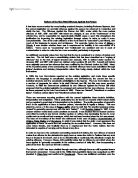A might be guilty of assault instead. The crucial issue regards to whether B did apprehend immediate violence. Yet, A could argue, as a matter of fact, that B could not have apprehended immediate violence, since the violence was too immediate to be apprehended - a bullet travels in the speed of light, B could not have noticed anything before he got hit. Nevertheless, P could argue that B could have apprehended another attack and thus apprehended immediate violence after the bullet hit him. In any case, it is a question of fact for the jury to decide.
For B’s serious injury, A could be liable for an offence contrary to s18 of the OAPA 1861, which is malicious wounding or causing of grievous bodily harm with intent. Since B sustained serious injury, the element of ’grievous bodily harm’ which merely denotes ’serious bodily harm’ (R v Saunders), is readily satisfied. The situation is similar for ‘causing‘: though the round hit B indirectly because it ricocheted, A had still caused the injury by virtue of the event being a natural consequence of the firing of the round (R v Hallet). But A might have a defence on the issue of mens rea. s18 requires proof of an intent to cause grievous bodily harm, and recklessness does not suffice (Belfon). Hence A has to be proven to have been ’virtually certain’ that B would sustain GBH or be wounded (Nedrick). This is difficult, as A could well argue that he did not expect the round to ricochet. Yet, in R v Ireland, it was held that ’grievous bodily harm’ includes ’serious psychological illnesses’. It is arguable that this could be of wider application. A might not be virtually certain that grievous physical harm would result, but as the facts showed that he intended to frighten B, he could have been virtually certain that serious harm to B’s mental well-being will ensue. If the court the extension of R v Ireland, the intention to cause grievous bodily harm would be established and A is guilty of an s18 offence.
Assuming that R v Ireland is not of wider application or the facts does not fit the requirements, prosecution could alternatively charge A of a s20 offence, where A must simply be proven to have been reckless as to whether some harm would result (Sullivan). The test for recklessness is subjective - A must had forseen the possibility of some harm (Cunningham). But since he could not be convicted of a battery because of the lack of mens rea, most likely this charge will fail as well (as mentioned, assuming that R v Ireland is not of wider application).
Alternatively then, A could be charged with s 47 OAPA assault occasioning actual bodily harm. It was said in R v Roberts, as long as an assault and actual bodily harm is established and that causation is proven between the two, no further mens rea is required. The element of ABH would easily be met, since the injury falls within the definition of ‘any interference with comfort‘ (Chan - Fook). Hence success of a conviction on s47 will depend on whether (as discussed above) there is evidence on A’s foresight of application of force, and evidence of B’s apprehension of immediate violence and the jury’s evaluation.
If R v Ireland is extended, A would be guilty of a s18 offence. If the jury is satisfied that B apprehended another episode of immediate violence right after he got hit, A would be guilty of a s47 offence as well. Otherwise, A would most probably be absolved from liability.








